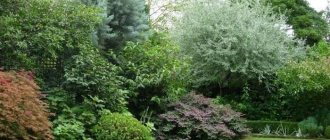A mixborder of perennials is decorative at any time of the year. That is why such a flower garden is very popular in landscape design. Creating a flower bed from many different and seemingly completely incompatible species and varieties of ornamental plants is an entire art.
When creating a mixborder from perennials with your own hands, the main thing is to stock up on theoretical knowledge and be patient. And in subsequent years you will admire the almost continuous flowering of your favorite plants.
Features of creating a “mixed” flower garden
The diversity of a mixborder is not a chaotic planting of a large number of plants of different species. Their sizes are also of great importance here. Tall people can go well with short people. Your task is to make the composition harmonious and beautiful.
How to make a beautiful mixborder from perennials, if here some flowers replace others? And those that bloomed in June should not “spoil” the appearance of the flowerbed in August? This is not allowed with a mixborder!
Thanks to the decorative nature of the leaves, some plants remain quite attractive even after flowering. The remaining leaves may not serve as a special decoration for the flower garden, but they remain neat and do not spoil the overall appearance.
Some perennials should not be planted in large masses in “mixed” flower beds. It is impossible to take your eyes off delphiniums, for example, during flowering. But after flowering, it is better to cut off their extinct flower stalks. This is easy to do if single specimens were planted. The resulting voids will always be covered by other plants. But, if several delphinium bushes were planted, it will be difficult to cover a large number of cut plants.
If, when creating a mixborder, it is not possible to select perennial plants that replace each other, then you can plant a small number of annual crops that will distract the eye from faded perennials.
Description
Mixborders in landscape design appeared in the 17th century. The concept itself comes from the French language. “Mix” is translated as “mixing”, and “border” is translated as “border”, “restriction”.
Today, a similar term denotes a flowerbed of any configuration, consisting of all kinds of vegetation, planted in a certain order.
In other words, modern gardeners understand a mixborder as a complex flower garden consisting of annuals, perennials, shrubs and herbs.
Such a landscape element is characterized by the combination of a number of varieties of green spaces, different in shape, size, color, and foliage texture.
The difference from a border or ridge is that planting in such a floral composition is carried out in a free, natural style.
Flowers are arranged in groups, with smooth transitions between them, without sudden changes in color and height.
At the same time, when planting them, it is necessary to focus on a carefully thought-out plan that takes into account many complex nuances.
The peculiarity of the mixborder is as follows: due to the well-chosen composition and correct layout, it retains its decorative properties throughout the season.
A similar flower garden looks equally attractive in both spring and autumn. Plantings are done in tiers, placing tall flowers in the background and low-growing flowers in the foreground.
The main stages of arranging a continuous flowering mixborder
First of all, you need to choose a place where the mixborder will be installed. This seemingly simple task is, in fact, very important. A mixed flower bed cannot be placed wherever you please. For perennial crops, the conditions surrounding them are very important.
Flower beds of free outlines should not be placed under the scorching rays of the sun or in damp, constantly shaded places. Everything should be in moderation. The optimal conditions for a mixborder of perennials will be open areas with moderate lighting.
Please note the following options:
- along the facade of the house;
- on a slight rise;
- on the edge of the terrace;
- as a living fence around the perimeter of the entire site;
- against the backdrop of the lawn;
- along garden paths.
The length of the mixborder is not limited, and depending on the types of plants, one part of it can be located in the sun, and the other in partial shade.
Determining the location
A border flower bed is made along the edge of something. It could be:
- house facade;
- fence;
- track.
The easiest way to build a mixborder with your own hands is at the base. A flower garden of this format is also planted on a slope. The absence of bright sunlight is important.
Design of the central part of the mixborder
The following ornamental trees and shrubs of deciduous or coniferous species can be planted as a basis:
- willow;
- viburnum;
- plum with red leaves;
- elder;
- magnolia;
- dwarf cedars, firs and thujas;
- jasmine;
- hibiscus;
- weeping larch.
They are planted at a certain distance from each other because they tend to grow. To rejuvenate and prolong flowering, these plants require timely pruning.
What plants and shrubs should I plant?
If you look at the finished diagram below, you can see that to create a mixborder, plants of different “heights” are required.
Tall
They are divided into coniferous and deciduous. The most light-loving tree with needles is considered to be blue spruce, the most shade-tolerant are fir or yew. Among deciduous trees, the sun loves barberry, hawthorn, and Japanese quince. Rowan and buckthorn, on the contrary, prefer to grow in the shade.
Medium height
This group includes deciduous and flowering shrubs, dwarf coniferous trees, tall flowers (for example, peonies). An example of bushes for the open sunny side: hydrangeas, phlox, fieldfare, lilac, mackerel, willow. Boxwood, spirea, mock orange, and juniper will take root in shady areas.
Important! Tall and medium-sized bushes serve as skeletal “supports” of the entire composition - they are planted first, and then they fill the remaining distance between them.
In the photo there is a flower garden along the fence
short
The lowest include some flowers for mixborders, herbs or vegetables - they are planted along the outer edge. Geranium, hosta, lupine, and saxifrage grow well in the shade. Among the sun-loving varieties are lavender, chrysanthemum, ground cover sedum, young, and awl-shaped phlox.
Arrangement of the middle tier of the mixborder
Tiering is an important principle for creating a mixed flower bed. Therefore, it is necessary to cover the elongated stems of “skeletal” trees and shrubs with medium-sized varieties of perennial plants. It can be:
- phlox;
- roses;
- delphiniums;
- asters and many other colorful perennials.
The combination of bright colors and lush greenery is a good solution when creating mixborders from perennials with your own hands. Therefore, you can dilute the beautiful flowers of the middle tier with the chic foliage of the following plants:
- majestic geranium;
- juniper;
- silvery leaves of cineraria;
- burgundy heuchera leaves, as well as many other plants with decorative foliage.
Examples in landscape design
When creating mixborders, it is better to learn from the mistakes of others and implement proven methods of effective decoration. For example, you can dilute the flower arrangement with spikelet grasses: pampas grass, barley, lagurus.
In order not to overdo it with color, choose one of your favorite flowers, and collect the main part of the composition from coniferous and deciduous shrubs.
The last piece of advice is if you plan to have a fountain/pond on your site, combine it with a mixborder. A multi-tiered flower bed is an excellent option for framing any decorative solution.
Creating a mixborder is like assembling a living construction set. Even if something didn’t work out right away, everything can be fixed: so don’t be afraid to start and experiment!
Mixborder foreground design
Borders of mixed flower beds require special attention. It is better to frame the flower bed from plants with bright flowers and lush green leaves. The following plants can be planted in front:
- horned violet;
- bell;
- asters;
- hybrid carnation;
- irises;
- lilies, etc.
To make the overall picture of the flower garden more elegant, you can plant variegated annuals between the perennial plants. Spring primroses should smoothly pass the baton to plants that actively bloom in the summer. And those will give way to autumn-flowering species of perennials.
Color solutions for mixborders
The combination of shades is an important point in the design of “mixed” flower beds. The flower garden should fit well into the overall design of the garden plot. When designing a mixborder, you can use the following color combinations:
- the most successful combinations of spring freshness are blue and white shades: daisies with snowdrops or delphiniums, as well as white tulips with pale blue bells;
- For romantics, lilac, soft pink and scarlet colors of flowers are suitable. Pink phloxes, for example, will give a great mood in combination with irises or roses, with lilac bushes or lilies;
- the effect of a flaming flower garden can be created using orange, bright yellow and red shades. For example: the center of the circle is red, which is framed by orange shades, and plants with yellow flowers complete all this beauty. For such a composition you can plant gerberas and asters.
Helpful care tips
Mixborder needs regular watering, fertilizing and pruning
With a competent approach to choosing plants for a mixborder and its location on the site, problems with care do not arise. The main task is to maintain decorativeness throughout the season. This requires:
- observe regular watering, spray the leaves during dry periods;
- apply mineral fertilizers at least 2 times a summer to enhance flowering and growth;
- remove weeds, loosen the soil;
- trim all overgrown, dry and deformed shoots, and also shape the bushes in autumn and spring.
The use of fungicides and insecticides is only required when characteristic signs of infestation are detected. For preventive purposes, treatment is usually not carried out.











